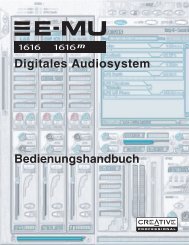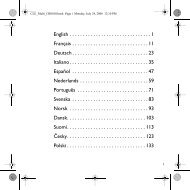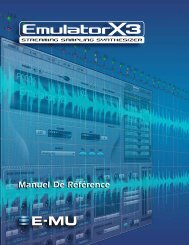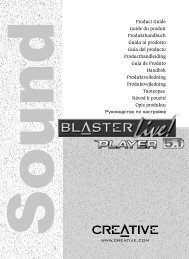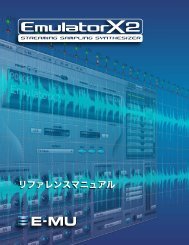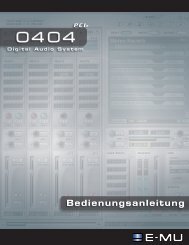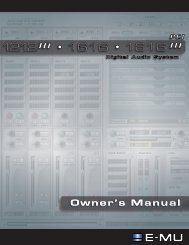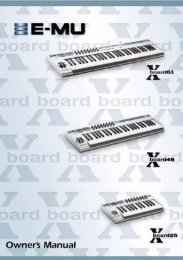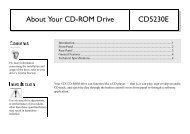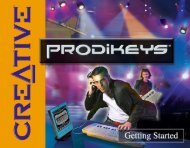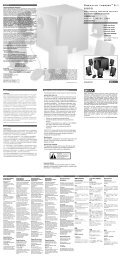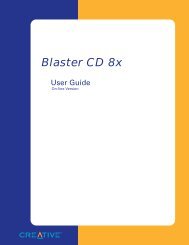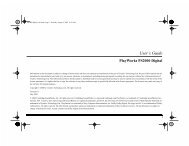Owner's Manual - Creative
Owner's Manual - Creative
Owner's Manual - Creative
You also want an ePaper? Increase the reach of your titles
YUMPU automatically turns print PDFs into web optimized ePapers that Google loves.
Owner’s <strong>Manual</strong>
Owner’s <strong>Manual</strong><br />
© 2009 E-MU Systems<br />
All Rights Reserved<br />
Revision: E<br />
E-MU World Headquarters<br />
E-MU Systems<br />
1500 Green Hills Road<br />
Scotts Valley, CA 95066<br />
USA<br />
Europe<br />
<strong>Creative</strong> Labs (Ireland) Ltd<br />
Ballycoolin Business Park<br />
Blanchardstown, Dublin 15<br />
IRELAND<br />
Japan<br />
<strong>Creative</strong> Media K. K.<br />
Kanda Eight Bldg., 3F<br />
4-6-7 Soto-Kanda<br />
Chiyoda-ku, Tokyo 101-0021<br />
JAPAN<br />
2 E-MU Systems
TABLE OF CONTENTS<br />
Introduction ................................................................................. 5<br />
Package Includes .......................................................................... 6<br />
Computer Requirements ............................................................... 7<br />
Windows ..........................................................................................................7<br />
OS X .................................................................................................................7<br />
Software Installation .................................................................... 8<br />
Windows XP or Windows Vista ..........................................................................8<br />
Note About Windows Logo Testing ................................................................8<br />
Uninstalling all Audio Drivers and Applications ................................................8<br />
Macintosh OS X .................................................................................................9<br />
Uninstalling the Audio Drivers and Applications ............................................11<br />
Connection Diagram .................................................................. 12<br />
Controls & Headphone Output ................................................... 13<br />
Input/Output ............................................................................. 14<br />
E-MU USB Audio Control Panel ................................................... 15<br />
Direct Monitoring ....................................................................... 16<br />
Audio Recording Software .......................................................... 17<br />
Before you Begin... ......................................................................................17<br />
Troubleshooting ......................................................................... 18<br />
Internet References .................................................................... 19<br />
Forums ........................................................................................................19<br />
Technical Specifications .............................................................. 20<br />
Declaration of Conformity .......................................................... 22<br />
Index ......................................................................................... 25<br />
0202 USB 2.0 Owner’s <strong>Manual</strong> 3
4 E-MU Systems
Introduction<br />
INTRODUCTION<br />
Thanks for your purchase of the E-MU 0202 USB 2.0 Audio/MIDI Interface. This<br />
interface brings an unparalleled level of USB audio quality to the Mac or PC, with<br />
pristine 24-bit/192kHz A/D and D/A converters, ultra-low jitter clock, and Class-A,<br />
ultra-low noise mic/line/hi-Z preamps. The signal-to-noise specs of the<br />
E-MU 0202 USB 2.0 are unmatched by any other USB interface on the market!<br />
From its plug-and-play functionality and hands-on ergonomic design, to professional<br />
features like zero-latency direct monitoring and balanced outputs, the USB<br />
will forever change your expectations of USB audio.<br />
Some of the other key features are detailed below:<br />
• Record and Playback support for a multitude of sample rates : 44.1k, 48k, 88.2k,<br />
96k, 176.4k, 192k. (176.4k &192k available on PC version only)<br />
• Independent ground lift switches for both analog inputs help to solve potential<br />
ground loop problems<br />
• Studio-Grade Headphone Amplifier with level control<br />
NOTE<br />
There are some limitations<br />
when operating at higher<br />
sample rates. See page 15<br />
for details.<br />
0202 USB 2.0 Owner’s <strong>Manual</strong> 5
Package Includes<br />
PACKAGE INCLUDES<br />
• E-MU 0202 USB 2.0 AudioPod<br />
• USB Cable<br />
• Quick Start Installation Guide<br />
E-MU Software/<strong>Manual</strong> CD-ROM (OS X /Windows)<br />
• Windows XP, Windows XP x64, Windows Vista, Windows Vista x64 Drivers<br />
• Mac OS X Drivers<br />
• Owner’s <strong>Manual</strong><br />
Acoustica Mixcraft LE 4 Install CD-ROM (Windows)<br />
• Acoustica Mixcraft LE 4 (multitrack recording application)<br />
6 E-MU Systems
Computer Requirements<br />
COMPUTER REQUIREMENTS<br />
The minimum computer system requirements for the E-MU 0202 USB 2.0 are<br />
listed below.<br />
Windows<br />
• Intel® or AMD® processor — 1.2 GHz or faster<br />
• Intel, AMD, or 100% compatible motherboard & chipset<br />
• Microsoft® Windows® XP (SP 2 or greater), Windows XP x64, Windows Vista,<br />
Windows Vista x64<br />
• 1 available (Hi-Speed) USB 2.0 port *<br />
• 500 MB System RAM<br />
• 95 MB of free hard disk space for full installation<br />
• CD-ROM/CD-RW or DVD-ROM drive required for software installation<br />
• XVGA Video (1024 x 768)<br />
OS X<br />
• Apple® Macintosh® G4 —800 MHz or faster<br />
NOTE: For more information on Intel Mac support see the included ReadMe file, and/<br />
or www.emu.com for latest information.<br />
• Apple Macintosh OS X (10.4.3 or greater)<br />
• 1 Available (Hi-Speed) USB 2.0 port †<br />
• 512 MB System RAM<br />
• 500 MB of free hard disk space for full installation<br />
• CD-ROM/CD-RW or DVD-ROM drive required for software installation<br />
• XVGA Video (1024 X 768)<br />
* When using a USB 1.1 port, performance is limited to16-bit and 44.1/48 kHz recording<br />
and playback.<br />
† USB 1.1 is not supported on the Macintosh<br />
0202 USB 2.0 Owner’s <strong>Manual</strong> 7
Software Installation<br />
SOFTWARE INSTALLATION<br />
Windows XP or Windows Vista<br />
Follow these instructions to install the 0202 USB 2.0 software on a Windows XP or<br />
Windows Vista computer.<br />
1. First connect the 0202 USB 2.0 to your computer using the supplied USB<br />
cable, and turn it on.<br />
2. If Windows prompts you with an Add New Hardware Wizard, click Cancel.<br />
3. Insert the E-MU software Installation CD into your CD-ROM drive. If<br />
Windows AutoPlay mode is enabled for your CD-ROM drive, the CD starts<br />
running automatically. If not, from your Windows desktop, click Start->Run<br />
and type d:\setup.exe (replace d:\ with the drive letter of your CD-ROM<br />
drive). You can also simply open the CD and double-click Setup.exe.<br />
4. The installation splash screen appears. Follow the instructions on the screen to<br />
complete the installation. You will have the option to install 0202 USB 2.0,<br />
and Adobe Acrobat Reader.<br />
5. Choose “Continue Anyway” when you encounter the “Windows Logo<br />
Testing” warning screen. See the note below.<br />
6. When prompted, restart your computer.<br />
7. Be sure to register your 0202 USB 2.0 so we can advise you of future software<br />
updates and special offers. You can register online at: www.emu.com/register<br />
8. Your 0202 USB 2.0 is now ready to use.<br />
9. Insert the Acoustica Mixcraft LE 4 Install CD-ROM into your CD-ROM drive.<br />
10. The installation splash screen appears. Follow the instructions on the screen to<br />
complete the installation.<br />
Note About Windows Logo Testing<br />
When you install the 0202 USB 2.0 drivers, you will see a dialog box informing<br />
you either that the driver has not been certified by Windows Hardware Quality<br />
Labs (WHQL), or that the driver is signed by <strong>Creative</strong> Labs, Inc, and you will be<br />
asked if you would like to continue with the installation.<br />
The 0202 USB 2.0 audio drivers are not certified by WHQL because the product<br />
does not support some of the features that the Microsoft Windows Logo Program<br />
requires, most notably Universal Audio Architecture (UAA) and Digital Rights<br />
Management (DRM).<br />
Despite this, the 0202 USB 2.0 audio drivers have been rigorously tested using the<br />
same test procedures that a WHQL qualified driver requires, and it passes in all of<br />
the other important categories, including those that measure the relative stability<br />
of the driver. So, it is perfectly safe to install these drivers on your computer.<br />
Uninstalling all Audio Drivers and Applications<br />
At times you may need to uninstall or reinstall the 0202 USB 2.0 application and<br />
device drivers to correct problems, change configurations, or upgrade outdated<br />
drivers or applications. Before you begin, close the E-MU USB 2.0 Audio control<br />
application. Applications running during the uninstallation will not be removed.<br />
1. Click Start -> Control Panel.<br />
2. Double-click the Add/Remove Programs icon.<br />
3. Click the Install/Uninstall tab (or Change or Remove Programs button).<br />
4. Select the E-MU 0202 USB 2.0 entry and then click the Change/Remove<br />
button.<br />
8 E-MU Systems
Software Installation<br />
5. In the InstallShield Wizard dialog box, select the Remove ALL option.<br />
6. Click the Yes button.<br />
7. Restart your computer when prompted.<br />
You may now re-install existing or updated E-MU device drivers or applications.<br />
Macintosh OS X<br />
Follow these instructions to install the 0202 USB 2.0 drivers and software on a<br />
Macintosh OS X computer. First, connect the 0202 USB 2.0 to your computer as<br />
shown on page 12.<br />
Install the 0202 USB 2.0 Software<br />
1. Insert the E-MU Software/<strong>Manual</strong> CD-ROM into your CD-ROM drive.<br />
2. Double-click on the E-MU icon on the desktop.<br />
3. Double-click on the Install icon to start the installation.<br />
4. The installation Welcome screen appears. Follow the instructions on the<br />
screen.<br />
5. When the Authenticate dialog box appears, enter the administrator password<br />
you chose when you installed OS X.<br />
6. Continue to follow the instructions on the screen to continue the installation.<br />
You will be given the option to install:<br />
• Easy Install: Installs the following applications and drivers.<br />
E-MU 0202 USB 2.0: USB Drivers and Control Application<br />
• Custom Install: allows you to choose which components are installed.<br />
7. Easy Install is recommended. The software will be quickly installed. When<br />
prompted, restart your computer.<br />
8. Be sure to register your 0202 USB 2.0 so we can advise you of future software<br />
updates and special offers. You can register online at: www.emu.com/register<br />
Set-up the 0202 USB 2.0 as your Default Audio Device<br />
9. Click Go -> Utilities from the menu bar.<br />
10. Double-click Audio MIDI Setup, then click the Audio Devices button if it’s<br />
not already selected. The window shown on the following page appears.<br />
11. Select the 0202 USB 2.0 for the following: Default Input, Default Output,<br />
System Output, Properties For.<br />
12. Play a song on iTunes to verify that the 0202 USB 2.0 is the default device for<br />
audio playback.<br />
13. Quit iTunes.<br />
0202 USB 2.0 Owner’s <strong>Manual</strong> 9
Software Installation<br />
Setup the MIDI Devices<br />
If you plan to use a MIDI keyboard, now would be a good time to set up your MIDI<br />
devices. Connecting a MIDI keyboard will allow you to use the virtual instruments<br />
provided in the software bundle and get the most out of your purchase. You’ll also<br />
need a MIDI interface such as the E-MU Xmidi 2x2 or Xmidi 1x1.<br />
14. Click the MIDI Devices button. The window shown below appears.<br />
15. Click the Add Device button. A new external<br />
device icon like the one shown at left appears.<br />
16. Double-click on the new external device if you<br />
want to set the MIDI Keyboard Properties. You<br />
have the option to name and change the icon<br />
for the device. Click Apply, then click the Close<br />
button to close the Properties window.<br />
10 E-MU Systems
Software Installation<br />
17. Connect the new external device to the E-MU 0202|USB by dragging between<br />
the input and output connectors.<br />
18. The window below shows a properly connected MIDI device.<br />
19. Press the close button to close the Audio MIDI Setup window.<br />
What audio software can I use with my 0202 USB?<br />
The 0202 is compatible with most Macintosh audio applications. Garage Band is a<br />
good way to get started if you don’t have a pro audio recording application.<br />
Uninstalling the Audio Drivers and Applications<br />
At times you may need to uninstall or reinstall the 0202 USB 2.0 application and<br />
device drivers to correct problems, change configurations, or upgrade outdated<br />
drivers or applications. Before you begin, close the E-MU USB 2.0 Audio control<br />
panel application. Applications running during the uninstallation will not be<br />
removed.<br />
1. Open the Applications folder.<br />
2. Open the <strong>Creative</strong> Professional folder.<br />
3. Open the E-MU USB Audio folder.<br />
4. Click the E-MU USB Audio Unistaller and follow the instructions.<br />
0202 USB 2.0 Owner’s <strong>Manual</strong> 11
Connection Diagram<br />
WARNING!<br />
Use only a USB 2.0<br />
certified Hi-Speed cable<br />
(like the one supplied) for<br />
the USB connection. Using<br />
a USB 1.1 cable may cause<br />
erractic behavior and<br />
degraded performance.<br />
CONNECTION DIAGRAM<br />
Computer<br />
USB 2.0<br />
12 E-MU Systems<br />
Outputs<br />
Inputs<br />
R L Stereo R - Hi Z / Line<br />
1/4” male to 1/4” male<br />
(unbalanced)<br />
Powered Speakers<br />
Microphone<br />
or Line<br />
L - Mic L - Line Mic
Controls & Headphone Output<br />
CONTROLS & HEADPHONE OUTPUT<br />
1<br />
2 3 4 5 6<br />
1. Signal Level & Clip Indicators<br />
The LED signal level indicators show that you are inputing a proper signal<br />
level. With a proper input level, the green signal LED should be flickering, but<br />
the red clip indicator should NOT ever be lit.<br />
The clip indicators light and show that the input level has exceeded0 dBFS.<br />
2. Left/Right Gain Controls<br />
These controls set the input gain from 0dB to +60dB for the two inputs.<br />
3. Direct Monitor Level Control<br />
This continuous encoder controls the amount of direct monitor signal mixed<br />
into the outputs. The level is adjustable from -24dB to off.<br />
4. Direct Monitor On/Off & Mono-Stereo Switch<br />
Press the button to turn Direct Monitoring on and off and to switch modes.<br />
The stereo LED illuminates. The left and right channels are passed through to<br />
their respective outputs at the level set by the Direct Monitor Level control.<br />
Press the button again to sum the left and right direct monitor channels to<br />
mono. Mono mode is useful when the two inputs are being used for separate<br />
instruments. See “Direct Monitoring” on page 16.<br />
5. Headphone Jack<br />
Connect your stereo headphones here.<br />
6. Headphone Level Control<br />
This knob controls the volume of the headphone output. This switch also<br />
turns the 0202 USB 2.0 on or off.<br />
0202 USB 2.0 Owner’s <strong>Manual</strong> 13
Input/Output<br />
NOTE to PC Users:<br />
When using a USB 1.1 port,<br />
performance is limited to<br />
16-bit and 44.1/48 kHz<br />
recording and playback.<br />
System Volume Control<br />
Mac<br />
PC<br />
INPUT/OUTPUT<br />
USB 2.0<br />
Outputs<br />
7. USB<br />
Connects the 0202 USB 2.0 to your computer via the supplied USB cable. The<br />
USB connection provides two-way communication when connected to the<br />
computer.<br />
The 0202 USB 2.0 receives its power from the USB. Always connect to the USB<br />
jack on the computer itself and NOT to a low-power USB connection that<br />
may be present on your computer keyboard or other USB peripheral.<br />
8. Main Outputs<br />
The balanced outputs are normally connected to your monitoring system. The<br />
signal is duplicated on a stereo 1/8¨ jack for easy connection to desktop<br />
stereo speakers. The outputs have been designed using a special noisecancelling<br />
circuit which reduces problems relating to ground loops. The main<br />
output volume can be controlled using the System Volume Control on your<br />
Mac or PC.<br />
9. R - Hi Z / Line Input<br />
This 1/4¨ input can be used as a Hi-Z instrument input (guitar/bass, etc.) or a<br />
line level input. The input is balanced, but accepts either balanced or unbalanced<br />
signals.<br />
10. L - 1/8¨ Mic Input<br />
Connect microphones with 1/8¨ plugs to this jack.<br />
11. L - Hi-Z / Line / Mic Input<br />
Use the XLR connector for microphones or balanced line level signals. Use the<br />
1/4¨ in the center of the XLR jack as a Hi-Z input for guitar/bass, or as a line<br />
level input. The input is balanced, but accepts either balanced or unbalanced<br />
signals.<br />
Ground Lift Switches<br />
There are “ground lift” switches for both analog inputs located on the bottom<br />
of the unit. These switches can be used to safely stop the hum if a ground loop<br />
occurs in your setup. See page 18 for more information.<br />
14 E-MU Systems<br />
Inputs<br />
R L Stereo R - Hi Z / Line<br />
L - Mic L - Line Mic<br />
7 8 9 10 11<br />
R-GND LIFT<br />
L-GND LIFT<br />
Input Grounded<br />
Input Ground Lifted<br />
The input ground is lifted when the A or B slide switch is closest to the GND LIFT label.
E-MU USB Audio Control Panel<br />
E-MU USB AUDIO CONTROL PANEL<br />
After you have successfully installed the audio drivers, launch the E-MU USB<br />
Audio control panel. The E-MU USB Audio control panel is shown below.<br />
• Windows: The E-MU USB Audio control icon will be visible in the Taskbar,<br />
which is normally located in the bottom right of the screen. It can<br />
also be launched from the Start Menu<br />
(All Programs, <strong>Creative</strong> Professional, E-MU USB Audio Application).<br />
• OS X The E-MU USB Audio control application is located in the Applications<br />
folder . You can also open the E-Control Application<br />
using the icon on the desktop.<br />
1<br />
4<br />
5<br />
2 3<br />
1. Skin<br />
Choose between different appearances for the E-MU USB Audio control<br />
panel.<br />
2. View<br />
Hide the application (Ctrl+H, Windows) You can restore the application by<br />
clicking the E-MU icon in the System Tray (Windows), or by clicking the<br />
E-MU icon in the Dock (OS X).<br />
3. Help<br />
About E-MU 0202 USB 2.0, Audio control, Launch <strong>Manual</strong>, Check Updates<br />
4. Device<br />
If you are using more than one E-MU USB Audio device, you can choose<br />
which unit is currently being controlled.<br />
5. Sample Rate<br />
Allows you to set the system sample rate: 44.1kHz, 48kHz, 88.2kHz, 96kHz,<br />
176.4kHz or 192kHz.<br />
NOTE<br />
There are some limitations<br />
when operating at 176.4/<br />
192k sample rates.<br />
PC - No Direct Monitor<br />
Mac - Disabled<br />
0202 USB 2.0 Owner’s <strong>Manual</strong> 15
Direct Monitoring<br />
NOTE<br />
Direct monitoring is not<br />
available at 176.4 or<br />
192 kHz.<br />
DIRECT MONITORING<br />
Direct monitoring allows you to monitor inputs without having any software<br />
open. It can also be used as an alternative to software monitoring if you desire the<br />
lowest latency monitoring possible.<br />
When using a computer for digital recording, an audible time delay occurs while<br />
the audio signal is being input to the computer, processed by the software and then<br />
returned to the output for monitoring. This time delay is called Latency.<br />
Latency becomes a problem when you have to use high buffer settings to conserve<br />
CPU resources. Because the 0202 USB 2.0 has hardware direct monitoring, you can<br />
enjoy zero latency regardless of your buffer setting.<br />
The Direct Monitor feature connects the input signals to the output when recording<br />
so that you can hear your performance without delay. The Direct Monitor level<br />
control lets you adjust the volume of the input signal in relation to the recorded<br />
tracks.<br />
Direct monitoring is controlled manually from the Direct Monitor switch on the<br />
0202 USB 2.0. It’s not necessary to turn it on in your recording application<br />
Latency (delay)<br />
Direct Monitoring vs. Software Monitoring<br />
Direct monitoring is lower latency and can also be used without software running<br />
(or even without a computer!).<br />
Software monitoring has the advantage of allowing audio effects or EQ added in<br />
the host software to be heard on the output. Its roundtrip latency depends on what<br />
latency is chosen in the ASIO configuration. If you choose to software monitor,<br />
make sure to disable direct monitoring. If both are enabled, you will experience a<br />
‘comb filter’ or doubling effect.<br />
16 E-MU Systems<br />
USB<br />
Software Monitoring<br />
Direct Monitoring<br />
Direct Monitoring allows you to listen to the direct sound of your instrument during<br />
recording, without the delay incurred by going to the computer and back.
Audio Recording Software<br />
AUDIO RECORDING SOFTWARE<br />
Now that you’ve installed the 0202 USB 2.0, you probably want to start using it!<br />
The 0202 USB 2.0 is only one half of the equation—the hardware interface that<br />
translates audio signals into the digital language of your computer. The second half<br />
of the equation is the software recording application, which records and allows<br />
you to edit the audio on your computer.<br />
Acoustica Mixcraft LE 4 <br />
We have included Acoustica Mixcraft LE 4 for PC users. Acoustica Mixcraft LE 4 is<br />
a full-featured multitrack recording application with effects, virtual instruments,<br />
VST and DirectX support and much more.<br />
Tutorials and Videos: http://www.acoustica.com/mixcraft/support.htm<br />
Macintosh Users<br />
Unfortunately we were not able to include a Macintosh recording application with<br />
the 0202 USB 2.0, however you can use Garage Band, a very cool music application<br />
that probably came bundled with your Mac. This application works well<br />
with the 0202 USB 2.0 and will get you started with audio recording.<br />
NEED MORE HELP?<br />
If you need additional help, please see:<br />
• Windows: Program Files\<strong>Creative</strong> Professional\E-MU 0202<br />
USB\Documents\3rdParty.htm.<br />
• OS X: Applications Drive\Library\Documentation\E-MU 0202 USB\<br />
3rdParty.htm<br />
Before you Begin...<br />
• You should have already installed the E-MU software on your computer<br />
• You should hear the computer sounds coming out of the E-MU 0202 USB 2.0<br />
and your speakers when you play a CD or an MP3 using Windows Media<br />
Player or iTunes. If not, make sure your E-MU 0202 USB 2.0 is properly<br />
connected according to the diagram on page 12.<br />
• A source of audio should be connected to the inputs (a microphone, musical<br />
instrument, or CD/MP3 player).<br />
WARNING!<br />
Windows Users - After<br />
checking your audio, be<br />
sure to quit Windows Media<br />
Player.<br />
0202 USB 2.0 Owner’s <strong>Manual</strong> 17
Troubleshooting<br />
TROUBLESHOOTING<br />
Can’t hear Windows Media Player in Windows<br />
If you have, or ever have had, another audio device installed in your PC, you may<br />
have to set the E-MU 0202 USB 2.0 as the “Default Audio Device”.<br />
1. Open the Control Panel, then select Sounds and Audio Devices.<br />
2. Click the Audio tab and select the E-MU 0202 USB 2.0 as the Default device<br />
under Sound Playback.<br />
3. Click the Volume button under Sound Playback and turn up Wave volume.<br />
You cannot record or monitor ASIO and WAVE at the same time. The first audio<br />
application you open controls the E-MU 0202 USB 2.0.<br />
Lost Communication<br />
Should you lose communication between your E-MU 0202 and an audio application<br />
(Ableton Live, Cubase, Sonar, etc.), the E-MU 0202 USB 2.0 drivers may<br />
need to be re-selected in your application.<br />
1. Go to your application's I/O settings, de-select the E-MU 0202 USB 2.0 for<br />
both input and output.<br />
2. Apply these changes and exit the dialog.<br />
3. Re-enter the application's preference settings and re-select the E-MU 0202 USB<br />
2.0 drivers. If this doesn’t work, the application may need to be restarted.<br />
Ground Loops<br />
In digital audio devices and computers, audio ground loops may appear as pitched<br />
tones, digital hash in the background, as well as the familiar 60 cycle hum.<br />
Ground loops are caused by a difference in ground potential between two pieces of<br />
equipment. Computer audio devices are particularly susceptible to ground loops<br />
because most computers were not designed with high quality audio in mind.<br />
The E-MU 0202 USB 2.0 contains built-in “ground lift” switches for both analog<br />
inputs in order to safely break the loop if a ground loop occurs in your setup.<br />
R-GND LIFT<br />
L-GND LIFT<br />
Input Grounded<br />
Input Ground Lifted<br />
The ground-lift switches are located on the bottom of the unit, close to the rear<br />
panel. The input ground is lifted when the A or B slide switch is closest to the GND<br />
LIFT label.<br />
Pops & Crackles<br />
Pops and crackling noises in the audio are most often caused by having the ASIO<br />
Buffer Size set too low. Adding audio tracks and VST plug-ins increases the load on<br />
your computer’s CPU. If your computer cannot keep up with all the tasks you are<br />
asking it to perform, pops and crackles may occur. In effect, increasing the ASIO<br />
buffer gives your computer “more time” to complete its assigned tasks. The<br />
hardware Direct Monitor feature of the 0202 USB 2.0 allows you to increase the<br />
ASIO Buffer setting without the associated latency problems during recording and<br />
overdubbing.<br />
USB hubs can create problems with digital audio and should be avoided whenever<br />
possible.<br />
18 E-MU Systems
Internet References<br />
Simultaneous WDM/ASIO Playback (PC only)<br />
The 0202 USB 2.0 only supports playing back one stream format at a time on the<br />
PC. Each of the three mentioned stream types has an associated priority. If a higher<br />
priority stream type is opened while a lower priority stream is already playing, the<br />
lower priority stream will stop playing. The stream priorities, from highest to<br />
lowest, are ASIO, WDM.<br />
USB 2.0 vs. USB 1.1 Operation (PC only)<br />
The 0202 can operate in USB 2.0 or USB 1.1 mode on the PC. The 96 kHz and 192<br />
kHz sample rates are only available while operating in USB 2.0. The included<br />
E-MU USB Audio Control panel software includes an indicator to let you know<br />
which mode the device is running in.<br />
0202 USB comes up in USB 1.1 mode (PC only)<br />
Always turn the 0202 USB power off before connecting or disconnecting the USB<br />
cable. Hot-plugging the unit with the power on can cause the 0202 to power-up in<br />
USB 1.1 mode. If you see the Windows message, “This device could perform<br />
faster…”, simply turn power off, wait a few seconds, then turn power on again.<br />
INTERNET REFERENCES<br />
The internet contains vast resources for the computer musician. A few useful sites<br />
are listed here, but there are plenty more. Check it out.<br />
Software Updates, Tips & Tutorials.. http://www.emu.com/support<br />
Setting up a PC for Digital Audio..... http://www.musicxp.net<br />
MIDI Basics.......................................... Search for “MIDI Basics” (many sites)<br />
MIDI & Audio Recording ................... http://www.midiworld.com<br />
MIDI & Audio Recording ................... http://www.synthzone.com<br />
Mixcraft................................................. http://www.acoustica.com/mixcraft/<br />
index.htm<br />
Forums<br />
Unofficial E-MU Forum ..................... http://www.productionforums.com/emu<br />
Sound-On-Sound Forum................... http://www.soundonsound.com<br />
Computer Music Forum..................... http://www.computermusic.co.uk/main.asp<br />
Home Recording Forum .................... http://homerecording.com/bbs<br />
Studio Central Forum ........................ http://www.tweakheadz.com<br />
KVR Forum........................................... http://www.kvr-vst.com/forum/search.php<br />
MIDI Addict Forum ........................... http://forum.midiaddict.com/search.php<br />
Sound Card Benchmarking............... http://audio.rightmark.org<br />
Driver Heaven Forum......................... http://www.driverheaven.net<br />
0202 USB 2.0 Owner’s <strong>Manual</strong> 19
Technical Specifications<br />
TECHNICAL SPECIFICATIONS<br />
General<br />
Sample Rates: 44.1, 48, 88.2, 96, 176.4, 192kHz from internal crystal with no<br />
sample rate conversion<br />
(Note: 176.4k & 192k sample rates not supported on Macintosh)<br />
Bit Depth: 24-bit I/O, 32-bit processing<br />
USB 2.0 Hi-Speed<br />
Full 24-bit resolution at all sample rates<br />
2 in/2 out channels<br />
Zero-latency direct hardware monitoring (disabled at 176.4/192kHz)<br />
ASIO2, WDM MME, Apple Core Audio and Core MIDI drivers<br />
Anti-Pop speaker protection minimizes noise during power on/off<br />
Ultra-low jitter clock subsystem:
Technical Specifications<br />
Analog Line Outputs (2)<br />
Type: balanced, AC-coupled, 2-pole low-pass differential filter<br />
D/A converter: CS4392<br />
Max Level: Consumer: +6.7dBV max (unbalanced)<br />
Frequency Response: (20Hz - 20kHz) 0.00/-.01dB<br />
Dynamic Range: (1kHz, A-weighted) 111dB<br />
Signal-to-Noise Ratio: (A-weighted) 112dB<br />
THD+N: (1kHz at -1dBFS) -98dB (.0013%)<br />
Stereo Crosstalk: (1kHz at -1dBFS) < -120 dB<br />
Headphone Amplifier<br />
Type: Class-A power amplifier<br />
D/A converter: CS4392 (shared with Line Out)<br />
Gain Range: 60dB<br />
Maximum Output Power: 16mW<br />
Output impedance: 22ohms<br />
Frequency Response: (20Hz–20kHz) +0.02/-0.08dB<br />
Dynamic Range: (A-weighted) 110dB<br />
Signal-to-Noise Ratio: (A-weighted) 108dB<br />
THD+N: (1kHz, max gain): 300ohm load -98dB (.0013%)<br />
Stereo Crosstalk: (1kHz at -1dBFS, 300 ohm load) < -91dB<br />
Dimensions / Weight<br />
Weight: 0.94 lb / 0.43 kg<br />
Dimensions:<br />
W: 6.5” H: 2.0” L: 5.5”<br />
W: 165 mm H: 50.8 mm L: 140 mm<br />
0202 USB 2.0 Owner’s <strong>Manual</strong> 21
Declaration of Conformity<br />
DECLARATION OF CONFORMITY<br />
Trade Name: E-MU Systems<br />
Model No.: EM8740<br />
Responsible Party: E-MU Systems<br />
Address: 1500 Green Hills Road<br />
Scotts Valley, CA 95066 U.S.A.<br />
This device complies with Part 15 of the FCC rules. Operation is subject to the<br />
following two conditions: (1) This device may not cause harmful interference, and<br />
(2) this device must accept any interference received, including interference that<br />
may cause undesired operation.<br />
CAUTION<br />
You are cautioned that any changes or modifications not expressly approved in<br />
this manual could void your authority to operate this equipment.<br />
Note:<br />
This equipment has been tested and found to comply with the limits for a Class B<br />
digital device, pursuant to Part 15 of the FCC Rules. These limits are designed to<br />
provide reasonable protection against harmful interference in a residential installation.<br />
This equipment generates, uses, and can radiate radio frequency energy<br />
and, if not installed and used in accordance with the instructions, may cause<br />
harmful interference to radio communications. However, there is no guarantee<br />
that interference to radio or television reception, which can be determined by<br />
turning the equipment off and on, the user is encouraged to try to correct the interference<br />
by one or more of the following measures:<br />
• Reorient or relocate the receiving antenna.<br />
• Increase the separation between the equipment and receiver.<br />
• Connect the equipment into an outlet on a circuit different from that to<br />
which the receiver is connected.<br />
• Consult the dealer or an experienced radio/TV technician for help.<br />
The supplied interface cables must be used with the equipment in order to comply<br />
with the limits for a digital device pursuant to Subpart B of Part 15 of FCC Rules.<br />
22 E-MU Systems
Declaration of Conformity<br />
Compliance Information<br />
United States Compliance Information<br />
FCC Part 15 Subpart B Class B using:<br />
CISPR 22 (1997) Class B<br />
ANSI C63.4 (2003) method<br />
FCC Site No. 958979<br />
Canada Compliance Information<br />
ICES-0003 Class B using:<br />
CISPR 22 (1997) Class B<br />
ANSI C63.4 (2003) method<br />
Industry of Canada File No. IC 5933<br />
European Union Compliance Information<br />
EN55024 (1998 w/A1:01 & A2:03)<br />
EN55022 (1998) Class B<br />
Australia/New Zealand Compliance Information<br />
AS/NZS CISPR 22 (2002) Class B using:<br />
EN55022 (1998) Class B<br />
Japan Compliance Information<br />
VCCI (April 2005) Class B using:<br />
CISPR 22 (1997) Class B<br />
ANSI C63.4 (2003) method<br />
VCCI Acceptance Nos. R-2160 & C-2332<br />
Attention for the Customers in Europe<br />
This product has been tested and found compliant with the limits set out in the<br />
EMC Directive for using connection cables shorter than 3 meters (9.8 feet).<br />
Notice<br />
If static electricity or electromagnetism causes data transfer to discontinue midway<br />
(fail), restart the application or disconnect and connect the USB cable again.<br />
0202 USB 2.0 Owner’s <strong>Manual</strong> 23
Declaration of Conformity<br />
24 E-MU Systems
Index<br />
INDEX<br />
A<br />
ASIO Buffer Size 18<br />
Audio Recording Software 17<br />
C<br />
Clip Indicators 13<br />
Computer Requirements 7<br />
Connection Diagram 12, 14<br />
D<br />
Device Select, E-Control 15<br />
Direct Monitor Controls 13<br />
Direct Monitoring 16<br />
Direct Monitoring vs Software Monitoring 16<br />
E<br />
E-Control Application 15<br />
G<br />
Gain Controls 13<br />
Ground Lift Switches 14, 18<br />
Ground Loops 18<br />
H<br />
Headphone Level Control 13<br />
Headphone Output 14<br />
I<br />
Inputs 14<br />
Internet References 19<br />
L<br />
Latency 16<br />
Lost Communication 18<br />
M<br />
Monitoring, direct vs software 16<br />
P<br />
Package Contents 8<br />
Pops & Crackles 18<br />
S<br />
Signal Level Indicators 13<br />
Simultaneous WDM/ASIO/AC-3 Playback 19<br />
Skin, selecting 15<br />
Software Installation<br />
Mac OSX 9<br />
Windows XP 8<br />
T<br />
Technical Specifications 20<br />
Testing Your Interface 17<br />
Troubleshooting 18<br />
U<br />
Uninstalling Drivers & App 8, 11<br />
USB 1.1 port 14<br />
USB 1.1 Warning Message 19<br />
USB 2.0 vs. USB 1.1 Operation 19<br />
USB Jack 14<br />
V<br />
Volume Control, controlling with computer 14<br />
W<br />
WDM/ASIO/AC-3 Playback 19<br />
Windows Logo Testing Note 8<br />
Windows Media Player, no audio 18<br />
0202 USB 2.0 Owner’s <strong>Manual</strong> 25



